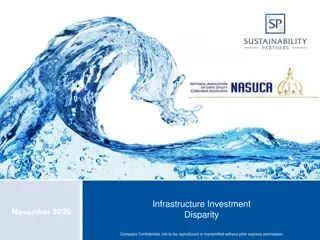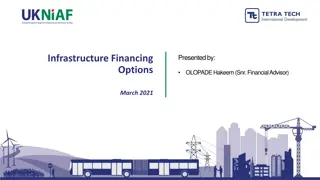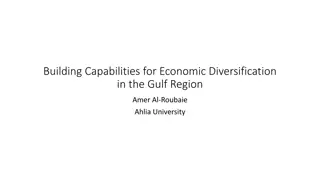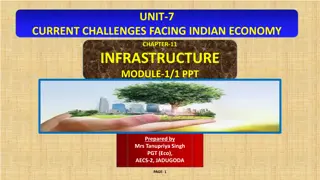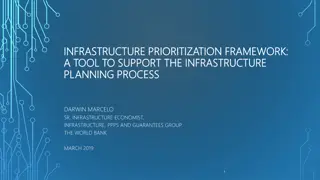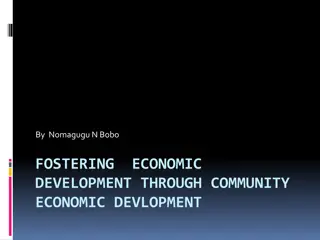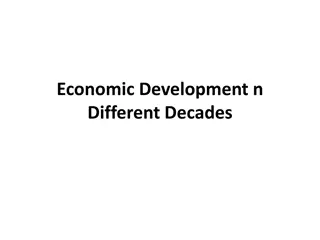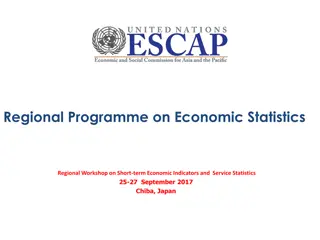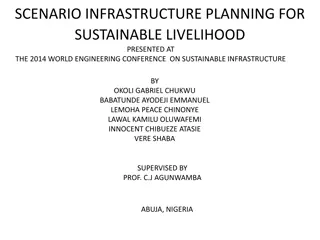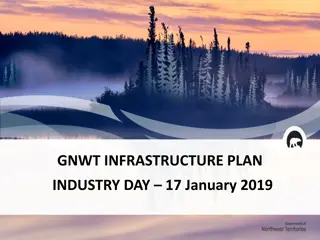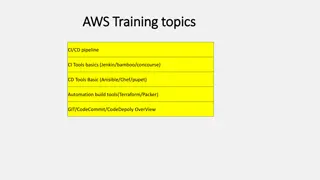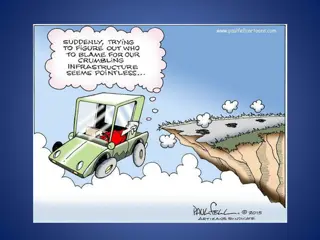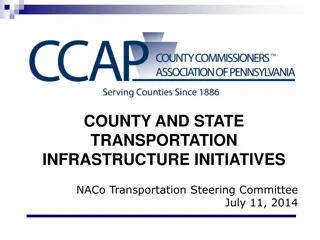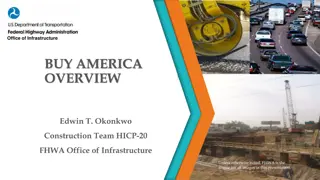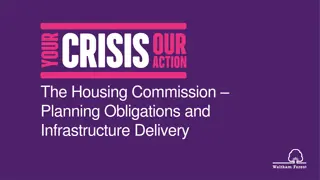Infrastructure and Economic Development Strategies for Casey Region
Partner and advocate to deliver sustainable and resilient infrastructure for Casey region. Utilize technology, promote innovation, and foster economic growth. Focus on revitalizing existing infrastructure, upskilling the workforce, and attracting new investments to create a vibrant and prosperous community.
Download Presentation

Please find below an Image/Link to download the presentation.
The content on the website is provided AS IS for your information and personal use only. It may not be sold, licensed, or shared on other websites without obtaining consent from the author. Download presentation by click this link. If you encounter any issues during the download, it is possible that the publisher has removed the file from their server.
E N D
Presentation Transcript
Draft Strategic Objectives and Strategies High Level Snapshot Click to add text
Infrastructure Strategy Strategic Objectives and Strategies Partner and Advocate to Deliver Infrastructure for Casey and the Region Improve and Utilise Technology & Digital Infrastructure Revitalise our Existing Infrastructure and Places Deliver Sustainable and Resilient Infrastructure 3.1 Develop and implement place-based revitalisation strategies to unlock investment, facilitate economic growth and create great places for our community, prioritising Cranbourne, Narre Warren, Hampton Park, and Berwick Activity Centres 1.1 Focus advocacy for timely delivery of State and Federal Government and non- government infrastructure with a focus on: 4.1 Deliver infrastructure that is carbon neutral and supports a circular economy 2.1 Create an integrated data and information platform to understand current and future service, demographic trends, and asset demands - reducing congestion and improving public and active transport options 4.2 Ensure infrastructure is resilient to the impacts of climate change with a focus on stormwater, foreshore and urban forest - connecting Casey community to regional infrastructure i.e., South East Airport, Clyde Regional Park, Recycled Water Pipeline, Thompsons Road, Advanced Waste Plant, Dandenong Rectangular Stadium. 2.2 Utilise technology to monitor, evaluate and inform asset performance, management and decision making 3.2 Effectively manage the lifecycle of infrastructure to ensure it is adapting to community needs, is fit for purpose, service standards are consistent, rationalised as appropriate, and our resources are utilised efficiently 4.3 Create a city that is at the forefront of integrated green and blue infrastructure within the urban realm 1.2 Utilise innovative procurement and funding strategies to deliver and manage infrastructure more effectively 2.3 Use community feedback to support the future direction and promotion of infrastructure 3.3 Rebalance the capital works prioritisation criteria to invest in upgrades, renewal, redevelopment or gaps in infrastructure to transform our existing infrastructure and places 4.4 Be future focused in trialing different ways to deliver infrastructure through material selection, interim and modular facilities, earlier delivery, using facilities owned by others 1.3 Partner with stakeholders to deliver, maintain, service, and manage our community infrastructure 3.4 Deliberately invest in a pipeline of infrastructure to be project ready
Economic Development Strategy Strategic Objectives and Strategies Innovate current strategic sectors and grow emerging sectors Advocate and partner on behalf of our regional business community Enable upskilling, skill alignment, and employment pathways Revitalise and preserve employment land and places Be investment ready 3.1. Foster an innovation, entrepreneurship and start-up ecosystem that increases business resilience 1.1. Establish and maintain investment facilitation and business development services that will support Casey businesses and prospective investors navigate government processes with ease 5.1. Connect workers with education institutions and businesses to upskill, reskill, or employ 4.1. Work with State and Federal Government, and non- government organisations to leverage infrastructure outcomes for Casey 2.1. Develop and implement place-based revitalisation strategies to unlock investment, facilitate economic growth and create great places for our community 3.2. Support growth of emerging technology sectors, including biotech, medtech, climate infrastructure, engineering, and advanced manufacturing 5.2. Facilitate employment accessibility through improved communication in the business community that resonates with our disadvantaged communities 4.2. Partner with local migrant communities, industry bodies, and Victorian and Australian governments to attract foreign direct investment and assist businesses export goods and services 1.2. Investigate how Council can attract new businesses and establish partnerships to increase investment and infrastructure 2.2. Engage and partner with landowners, developers, neighbouring councils, and state government to deliver connected, timely, and sufficient supply of employment land 3.3. Coordinate proactive engagement between local building, development, and construction sector and the Victorian government s Big Housing Build initiative 1.3. Increase transparency and quality of data across the organisation to enable more informed, real time decisions by Council and the community 4.3. In partnership with Greater South East Melbourne (GSEM) coordinate economic development and business advocacy at a regional level 3.4. Through the implementation of a Cultural Tourism Strategy, position Bunjil Place as a leading arts destination in Australia 2.3. Support local businesses and organisations to create remote work friendly places at home or in local neighbourhoods that retains people working from Casey 3.5. In partnership with elite sporting clubs, host major local sporting events 3.6. Deliver a program of works to support the growth and retention of existing businesses
Environment Strategy Strategic Objectives and Strategies Contribute towards a Circular Economy through Waste Management and Resource Recovery Conserve Enhance and Restore the Natural Environment Become a Climate Ready City Through Mitigation and Adaptation Create a Water Enhance People Capability and Internal Processes Efficient City 5.1 Build Organisation Capacity in Environmental Sustainability and Climate Change. 3.1 Improve Energy Efficiency and increase the use of Renewable Energy Sources to mitigate Climate Change. 2.1 Identify, conserve, enhance and restore the ecological values of Casey s Natural Environment particularly habitats of native plants and animals. 4.1 Improve water efficiency and increase the amount of water that is recovered for reuse and recycling. 1.1 Increase the quality of material sent to recycling facilities for processing. 1.2 Facilitate establishment of an Advanced Waste Processing facility in Southeast Melbourne 5.2 Improve Sustainable Procurement of Goods and Services. 3.2 Engage, Advocate and Empower the Community to reduce Carbon Emissions and Energy Consumption. 4.2 Reduce the amount and improve the quality of stormwater entering Port Phillip and Western Port Bay. 2.2 Increase canopy cover to contribute to a net gain in Casey. 5.4 Monitor, Review and Improve ESD outcomes in Council s built assets. 1.3 Facilitate roll out of Recycling Victoria s Kerbside Reform program. 3.3 Create an adaptive and resilient municipality which is responsive to a changing climate. 2.3 Empower the community to partner in biodiversity conservation and restoration initiatives. 4.3 Facilitate establishment of a South East regional integrated recycled water pipeline for the region. 5.5 Coordinate compliance to environmental legislation and other requirements. 1.4 Reduce Councils Corporate Waste, Improve Resource Recovery and increase use of recycled products. 2.4 Involve traditional owner groups in the management of Casey s Natural Environment to ensure traditional land management practices and values of Aboriginal people are embedded.
Health and Wellbeing Strategy Strategic Themes and Strategies Innovative and responsive models of service and connection Resilient, Safe & Connected Places Health and wellbeing across the life course Community research and data Bold and progressive leadership 3.1. Establish shared knowledge ecosystem of community needs in central research hub 5.1 - Address persistent and emerging employment vulnerability through leveraging Casey's strategic regional economic advantage in strongest recovering employment sectors (i.e. Education & Training and Healthcare and Social Assistance) 4.1. Embed social impact valuations in Council decision making 1.1. Strengthen the social context of place development by integrating organisational- wide place-based principles and practice (link to Infrastructure Strategy) 2.1. Develop virtual platforms to augment existing opportunities for social connection 3.2. Align health and wellbeing metrics to external framework (e.g. Sustainable Development Goals) 4.2 Strengthen alternative approaches to health and wellbeing, including arts-based practice and social prescribing 2.2. Increase digital equity to future-proof participation in community life 1.2. Support community-led COVID-19 pandemic recovery and strengthen public health response for current and future disease prevention 5.2. Embed understanding and value of Aboriginal and Torres Strait Islander culture, knowledge and history within organisation to drive equitable decision-making 3.3. Build and strengthen an organisational culture of research, evaluation, and reflective practice 2.3. Establish a framework for CSO attraction and funding streams 4.3. Partner with Strategic Service Planning to integrate best practice in health and wellbeing in Council service design 1.3 - Create safe and inclusive neighbourhoods and improve perceptions of community safety through social cohesion initiatives with particular focus on areas with high rates of crime, as well as perspectives of women, young people, and LGBTIQ+ and CALD communities 3.4. Align strategic environment internally and externally towards shared objectives and evidence 5.3 Embed deep understanding regarding intersectionality and equity within Council systems and drive progressive community dialogue 5.4 Define and leverage role as leaders on changes within sector (e.g. reforms, royal commissions)






